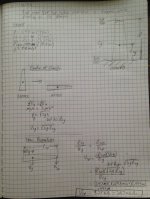I was wondering about something we all experience at least once and didn't know how to figure it out so I thought I would put it to you folks. Someonewill know the answer ehem Mr. Jewett?
If released from straight up and allowed to fall flat on the floor how fast is the tip of a pool cue moving when it hits the floor. Does it change with weight and balance?
Sent from my VS986 using Tapatalk
If released from straight up and allowed to fall flat on the floor how fast is the tip of a pool cue moving when it hits the floor. Does it change with weight and balance?
Sent from my VS986 using Tapatalk
